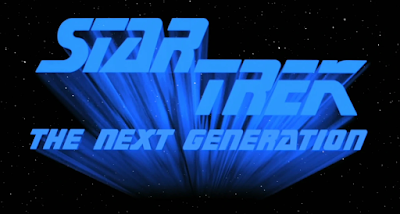 |
|
Published: 2013 Acquired: March 2019 Read: October 2020 |
2384 ("some months" after The Body Electric)
I can't claim I ever wanted a follow-up to Generations. "What was the nexus?" is a question I never even thought about. But The Stuff of Dreams brings the Enterprise
crew back into contact with that phenomenon, several decades ahead of schedule. Instead of passing through local space every 39.1 years, it's
returning 25 years early... and coming within the reach of the Typhon
Pact, who might like to have some easy access to time travel.
At first, I will admit I really didn't see the point of all this. The
nexus (always lower case, which feels wrong to me, like it's just some nexus, when surely it's the Nexus) is kind of a maguffin. The Enterprise has met up with the science vessel Newton, which has been studying the nexus for months; with the nexus about to enter Kinshaya space, the Newton
is going to destroy it so that no one can get their hands on it. But
there's a saboteur on board: it felt like this could have been any space
thing in any Typhon Pact story.
But then Picard returns to the nexus about halfway through the novella,
and the story gets wistful and melancholy and true. Picard has to
convince another man to give up the fantasies of the nexus while once
again confronting his own. The writing is tight and evocative and
character focused; as it goes on, it becomes genuinely moving, and I
found myself tearing up as I finished the novella over lunch. (Warning:
parenthood makes you into a total sap.) The reappearance of a certain Generations
character seemed obvious once it happened, but I didn't expect it, and I
really like what was done with him. It gave him good closure. Swallow
has a good grasp on Picard, and this is the first Destiny-era
story to convince me that there's something interesting in marrying
Picard off and giving him a family, the first one to tell a story that
could not have been told before.
And, I must admit, the more thriller-focused elements in the first half
work well; the culprit seems obvious, so I was surprised to be
wrong-footed. (And then Swallow puts a second surprise on top of the
first-- sneaky!)
It's quick, and that's to its advantage. One of the things I like about
these novellas is that they read like episodes of the television series;
Destiny-era fiction can often feel bloated, but The Stuff of Dreams gets right to it and never really wastes any time. It kind of makes me think all Star Trek tie-in fiction should be novella-length! Another thing I like is its perspective. A lot of Star Trek
books jump from character to character to character in a way that makes
it hard for the book to maintain any real throughlines; the choice of
viewpoint feels like it says more about the plot than anything else. The Stuff of Dreams focuses primarily on Picard, using him as the focal character for the majority of its scenes. But not every
scene is a Picard one; we'll segue into Worf or whoever when it's
needed, but we always quickly come back to Picard. So while this might
read like an episode in terms of pacing, in terms of character focus, I
think it plays to the strengths of prose instead of trying to emulating
tv-style ensemble storytelling.
So despite my initial skepticism, this turned out to be nice little
adventure of the kind I wish we saw more of. I think all of Swallow's Destiny-era books were Titan ones outside of this, so it's nice to get to see him do something different. I'd like to read more TNG by him.
Continuity Note:
Don't worry, these guys don't come back.
- One character, Kolb, is an old friend of Picard; it's mentioned they met when the Enterprise-D saved his planet, Styris IV, from Anchilles fever. I vaguely recognized those names, so I assumed he had appeared on some old episode of TNG that I had mostly forgotten. I was surprised when later I discovered he was an invention of this book-- Styris IV was where the Enterprise was going after "Code of Honor." I do wonder if there's a pre-established character Swallow could have used again to give things slightly more oomph. I am not a huge fan of the never-before-mentioned-old-friend trope!
I read Destiny-era Star Trek books in batches of five every
few months. Next up in sequence: Department of Temporal Investigations: Shield of the Gods by Christopher L. Bennett













































